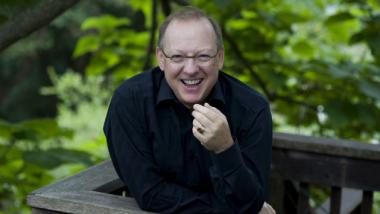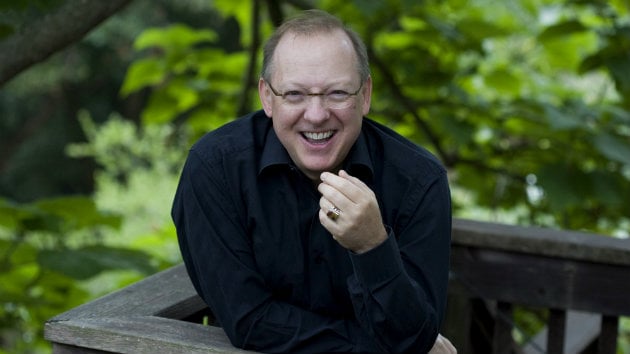
Thirty years ago, the founder of Philharmonia Baroque Orchestra, early music crusader and harpsichordist Laurette Goldberg tapped Nicholas McGegan to become Philharmonia’s music director. Under “Nic’s” leadership, a five-year-old ensemble previously run by four ensemble musicians who conducted orchestra business in a spare bedroom in the back of soprano Judith Nelson’s house was transformed into one of the world’s most captivating period ensembles.
Now, in addition to local concerts, Philharmonia also frequently tours here and abroad. And when the group is not performing and/or recording, McGegan travels the globe teaching, studying, and conducting major orchestras.
The challenge when interviewing Nic about his 30-year tenure is that he’s so witty, so enjoyable, and so filled with delicious, occasionally naughty insights into everything under the sun that it’s quite possible to lose one’s critical perspective entirely, hand him the reins, and go along for the ride. That, of course, is what so many of us do when we attend Philharmonia concerts and find ourselves lost in the splendid melodies, vivid colors, and multi-dimensional explorations that Nic and the orchestra eagerly share with us.
McGegan’s skills as a conductor, keyboard player, and flutist reflect a work-as-play worldview that leads him to describe as “tremendous fun” a recent weekend at Yale where he participated in a seminar on 18th-century art. As he tells it, he “did a little bit of music” and studied with an expert from Kensington Palace and other art historians. His perspective produces his own, particular take on early music, which he frequently imparts at the Juilliard School of Music in New York City, which is where SFCV reached him by Skype earlier this month.
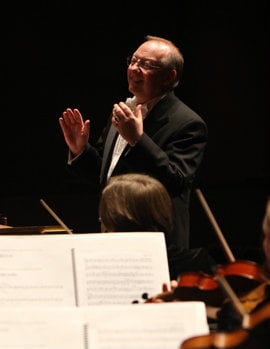
When Nic returns to Juilliard in November to conduct and teach, he will deliver a lecture on early British musical education and the sexing of instruments. “Harpsichord was a woman’s instrument, but obviously the cello was a man’s instrument,” he explains. “The gamba was an aristocratic instrument, and the violin was a low-class instrument. Ladies were allowed to play the gamba, because they could play it on a tuffet without opening their legs. And of course, ladies were not allowed to play wind instruments. Someone said how filthy it would be to see a woman with an oboe in her mouth.
“There’s a lovely, wicked line from Thomas Hardy, I think in ‘Under the Greenwood Tree,’ where someone says, ‘You can tell by the shape of them that clarinets were not made for the service of the Lord.’”
With a twinkle in his eye he proceeds:
“There was a kid in the 18th Century who was practicing the harpsichord in a window, and he was very dismayed to hear two guys walking past saying, ‘Isn’t it disgusting to see a boy playing the harpsichord? It’s a woman’s instrument.’ In Asia right now, you have an enormous number of female violinists, but very few wind players. The Duke of Wellington’s father was a violinist, and it’s said that he was the only aristocrat who could walk down Piccadilly carrying a violin without shame.”
McGegan was teaching this stuff way before he joined Philharmonia. The child of a painter and an architectural historian who were very happy to let him go off and do music, he grew up moving between disciplines. His knack for bringing it all together was reinforced when he attended Cambridge at 19 as a flute player (who also played piano), and the music department was attached to the theater and art department.
“I tended to flit between or among the various departments and have contacts and colleagues within them,” he reports. “It wasn’t like being at high school.”
In his second year at Cambridge, he enrolled in a course on the acoustics of buildings and instruments taught by Nicholas Shackleton. A collector of 18th-century clarinets, Shackleton loaned one to McGegan. At the top of his house he had a harpsichord-playing tenant named Christopher Hogwood.
“I got to know Chris, and I played in the very first recording of the Academy of Ancient Music,” he says. “That’s how I got the early music bug.”
When McGegan arrived in the United States in 1979, at age 29, it was to serve as artist-in-residence in Baroque music at Washington University in St. Louis. The gig lasted through 1985, during which time he ran a collegium, gave lectures on Baroque theater, and performed chamber music.
In 1982 or 1983, while doing some teaching at Oberlin Conservatory, he had a student named Bruce Brown. After Brown went to study with Laurette Goldberg in the early music program at San Francisco Conservatory of Music, and spoke highly of McGegan, an invitation arrived from Goldberg to give a talk at the conservatory.
“Philharmonia was still in diapers,” he reports.
He returned to the Bay Area in 1984 to guest conduct Philharmonia. With the orchestra wanting a single music director, and Goldberg thinking of moving on to her next project, the founding of MusicSources, McGegan was recruited.
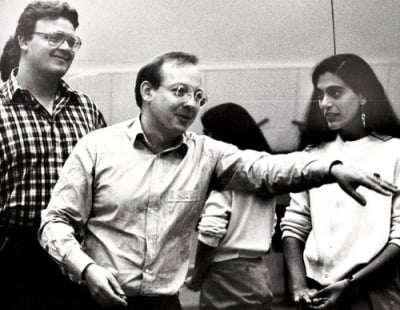
Up to that point, Philharmonia’s repertoire had consisted entirely of Baroque and early music. It didn’t take long before McGegan dared to move the clock ahead. Within one year of his appointment, he invited Malcolm Bilson to join the orchestra for Mozart's Concerto for Fortepiano No. 12. Philharmonia’s first Haydn performance, Symphony No. 49, followed in 1989. Every season since has included performances of Haydn and/or Mozart.
It didn’t stop there. An ear-opening performance of Beethoven's Symphony No. 1 in 1990 paved the way for Schubert’s "Unfinished" Symphony in 1992. In 2010, the orchestra even dared to raise its pitch to A=440 Hz for Brahms's Serenade No. 1 and Violin Concerto with soloist Viktoria Mullova. Philharmonia played Brahms on the “later” period instruments whose sound Brahms knew intimately.
“We started playing this music much to the horror of the Recorder Lobby,” Nic confides. “They wanted us to stick to what they thought period instruments meant: wall-to-wall Bach and Telemann, and nothing naughty like Haydn or other ‘late music.’”
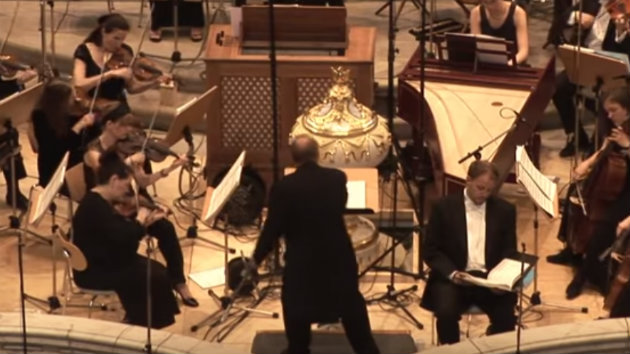
The resistance, it seems, was rooted in the counterculture nature of the Bay Area early music scene’s audience.
“Philharmonia set itself up in a slightly brown rice-and-Birkenstocks sort of way to be an alternative thing,” he says. “Our players were fine with it, but our Berkeley audience wanted to have something distinct from everything else. Doing Mozart was seen, in either/or fashion, as joining the mainstream a little bit. My argument was that if you play Mozart on period instruments, it is very distinct, and very different from how the symphony plays it. I'm not saying that one is better than the other; it’s just a different approach.
“I think about 30 years ago. there used to be these terrible things called ‘The Battle of the Bands’ where a period instrument orchestra would be put up against a modern orchestra, as if there was really a battle. And actually, there isn’t. Both orchestras could play equally well. But there was a certain snobbism on both sides. The period instrument guys were a bit holier-than-thou sometimes, a bit hoity toity, and sometimes the modern instrument guys were a bit dismissive, like, you know, we can really play, and you guys are playing period instruments because you can’t really play real ones. Of course, they said that until they tried, and they realized how hard it was.”
The PBO Family Sound
One measure of McGegan’s success is that the orchestra’s schedule has increased from approximately a dozen concerts a year to close to 40. Performing more frequently has helped Philharmonia develop a distinct sound that reflects, in part, McGegan’s irrepressible effervescence. “I went to a concert earlier this year —I won’t tell you which orchestra it was — in which the only time anyone onstage smiled was when they weren’t playing. And I thought, ‘Why do people pay for this?'"
“I went to a concert earlier this year —I won’t tell you which orchestra it was — in which the only time anyone onstage smiled was when they weren’t playing,” he reports. “And I thought, ‘Why do people pay for this? Why does the audience pay to watch people be miserable?’ They were playing Bach — it was joyous Brandenburgs and all that sort of thing — but they all looked as if their pets had just died.
“If we’re not enjoying it, I don’t think there’s much hope for the audience, frankly. That doesn’t mean you should look happy during miserable music. But it’s about emotion. Just because these composers are dead doesn’t mean it’s emotionally dead.
“Our job is as communicators. Sometimes that’s joy, and sometimes it’s despair. Whatever it is, you’ve got to communicate it. You’ve also got to respond to it. You have to have some background. I think one of the things about period instrument stuff, away from the nitty gritty technical [details] of flute fingerings and stuff like that, is knowing more than just the notes. It’s knowing about composers back then. Just because they wore wigs and gold clothes doesn’t mean that they didn’t have beating hearts. And it’s knowing what it means when folk themes show up. Knowing about dance tempos. Just knowledge. How to use it, of course, is a matter of discretion.”
This is where McGegan’s distinct approach to the language of Haydn, Handel, Rameau, and the like comes in. Where instrumentation and instructions are not indicated, as is often the case with early music, he and Philharmonia have come up with their own way of filling in the blanks.
“When an orchestra in the 18th Century played Handel, they probably played not much else,” says Nic. “They knew Handel’s language without having to write in a lot of extra notation about whether notes were long or short, or what articulations were wanted. And since Handel was often their conductor, if someone didn’t know, he could tell them.
“I’m not trying to give myself airs when I say that I suppose I’m the Handel substitute. I think Handel would have said, ‘I think it should go like this.’ I had to say that in 1985, and I still have to say it. But I’m saying it less and less, because we just do it like we did the last one.”
Philharmonia’s sound also reflects its consistent membership. With only one orchestra member lost to AIDS, its personnel have remained remarkably stable over three decades. Even without McGegan saying anything, musicians know what to expect. As he explains, “If a group of people basically plays together for 30 years, they’re going to start to become a family and begin to finish each other’s musical sentences, if you like.”
It doesn’t take an expert to appreciate that musicianship.
The Scarlatti Premiere
A rather hot fall may be upon us, but that won’t stop Nicholas McGegan from opening Philharmonia Baroque’s season with the North American premiere of a forgotten work, 300-year-old work, Alessandro Scarlatti’s La gloria di primavera, that exalts the glories of springtime and beyond in order to celebrate a very special human birth. A grand serenata for orchestra and soloists, it was composed by Neapolitan court composer Scarlatti for the 1716 birth of the expected heir to the Holy Roman Empire, Hapsburg Prince John Leopold. Although intended for a single performance, it pleased people so much that it was performed on multiple occasions until ...
“The good part is that it was written for the prince’s birth,” says Nic. “The bad part is that the prince didn’t live. His sister did, and she became [Empress] Maria Theresa. Because she was a girl, we had the War of the Austrian Succession and all that rubbish.”
With the prince gone, the work languished until earlier this year, when Scarlatti scholar Benedikt Poensgen, the former manager of McGegan’s Handel Festival in Germany, came across one of several existing manuscripts and made a nice edition of it. (An American scholar in Rome did another edition). Only a single modern performance in Europe precedes its October 4, North American premiere in Berkeley. Next spring, Philharmonia performs it in Carnegie Hall. “Anything written for the Hapsburg Dynasty has money behind it, so it calls for a lavish orchestra and five singers who are basically the seasons plus Jove, the King of the Gods. All sing in praise of the Grand Bambino.”
“It’s a very fancy piece,” Nic says. “Anything written for the Hapsburg Dynasty has money behind it, so it calls for a lavish orchestra and five singers who are basically the seasons plus Jove, the King of the Gods. All sing in praise of the Grand Bambino.”
Because he travels around the world conducting a lot of Messiahs, McGegan encounters lots of talented singers. (Tenor Nicholas Phan, one of the soloists in the piece, recently sang Britten with McGegan at the Dallas Symphony, and Haydn’s Creation with him in Minneapolis.) He also loves auditioning singers here, in Juilliard, and other places. Hence his frequent, and frequently exciting introduction of young artists to Philharmonia audiences, including a number of the soloists at the Scarlatti premiere.
“I’m going to have a whole couple of days listening to singers in New York in the spring,” Nic reports. “Part of the thing we can do is bring in the 23-year-olds. When I first brought in Dominique Labelle, I think she was 21. It’s great to bring these singers on and help them in their careers.”
It’s great for us as well. Even as he starts receiving Medicare, Nicholas McGegan constantly reaches for the new.
Correction, 10/1/2015: The article originally stated McGegan taught at Washington University in St. Louis until 1995. Actually it was 1985.

